How to write your first blog post using AI tools?

What’s the hardest part about writing your first blog post? Naturally, you feel intimidated when you first begin to explore the idea of starting your own blog. After all, it feels like there are so many blogs out there covering every topic imaginable. How can you stand out and build a loyal following? That’s why we’re here to help.
In this step-by-step guide, we will cover everything you need to know about how to write your first blog post in WordPress. If you are ready to take the plunge and start your own blog, read on for everything you need to know.
My mission in life is not merely to survive, but to thrive; and to do so with some passion, some compassion, some humor, and some style.
Maya Angelou
Write your first blog post with the help of the AI tool

It might be a headache for some individuals, like me, to write a blog for the first time, but thanks to artificial intelligence, it’s gotten a lot simpler. Using these AI technologies, we can create the foundational material, and then add to it as we thought. Consequently, create your first piece of content using one of these tools:
- ChatGPT : Chat GPT can be used to overcome writer’s block, create content more quickly, and improve SEO results. It can assist you in coming up with keyword ideas, titles, a post outline, and then fleshing out the post. It’s also excellent for creating “small copy,” such as meta-descriptions and social media posts. Use this blog to improve your content and SEO score
- Copy.ai: Write better marketing copy and content with AI – It helps the team with all kinds of copywriting and sales/copy including Product descriptions, ad copy, website copy, blogs, and emails.It’s for free for a user with limit of 2000 words per month
- Writesonic – Best AI Writer, Copywriting & Paraphrasing Tool – This tool simplify the process of creating, editing, and publishing SEO-optimized articles, blog posts, ads, landing pages, eCommerce product descriptions, social media posts, and many other forms of content. It’s for free for a user with limit of 6,250 words per month
- Creaitor.ai – Create compelling text with AI – It is an AI-powered writing assistant that helps you generate creative content for your website, blog, and social media accounts. It’s for free for a user with limit of 20,000 characters per month.
- Paraphrasing Tool | QuillBot AI – This tool will scan your writing and alert you to any errors in grammar, spelling, punctuation, word misuse, and more so that you can easily see what’s amiss and fix it fast.
I have used one of these tools and have created the initial content of this blog.
Add an image to your first blog post
The next step would be to generate a picture when you have finished writing your basic text and the title. Images are more appealing to viewers than a page of monochrome text, and it should offer a general summary of your site. It also makes it more engaging and improves your on-page SEO.
I made an image for my blog using Canva, which is free to use. Typically, I select an existing template that fits the topic of my blog and utilise Canva’s “Facebook Post(Landscape)” design.
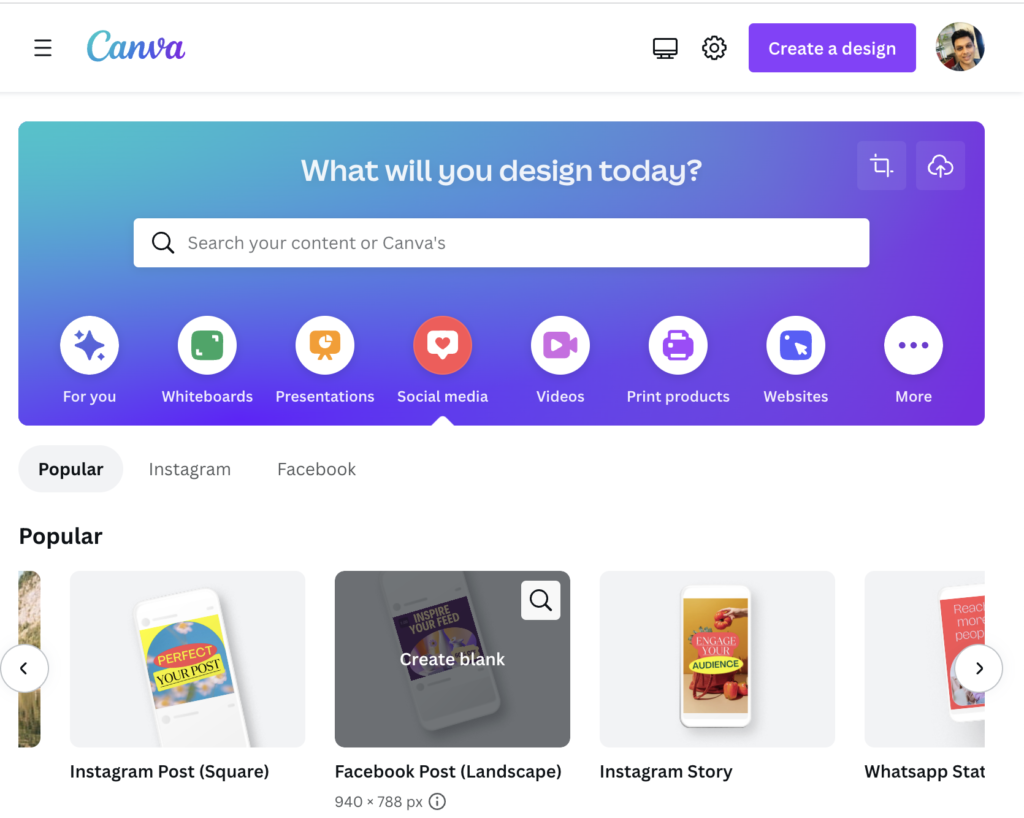
Every now and again, I add my material to pictures that I find on Google. The artificial intelligence graphic you see above was created by me by locating an image on Google and adding text on top of it. Even though there are other ways to download the image, I prefer the png format.
Additionally, you may use Canva to make infographics for your site if its primary goal is to give readers with information. Here is an example

Write your first blog post content using WordPress
I believe your blog should be written in an informal, conversational style overall. You may share your own experiences, and it might captivate the reader with intriguing information. There are three main sections in any blog post or article: the introduction, the body, and the conclusion. The introduction and conclusion are typically read by readers first to assess the content, and if they find it intriguing, they go on to the blog’s main content. Therefore, we will talk about these elements and assess what ought to be mentioned in the introduction.
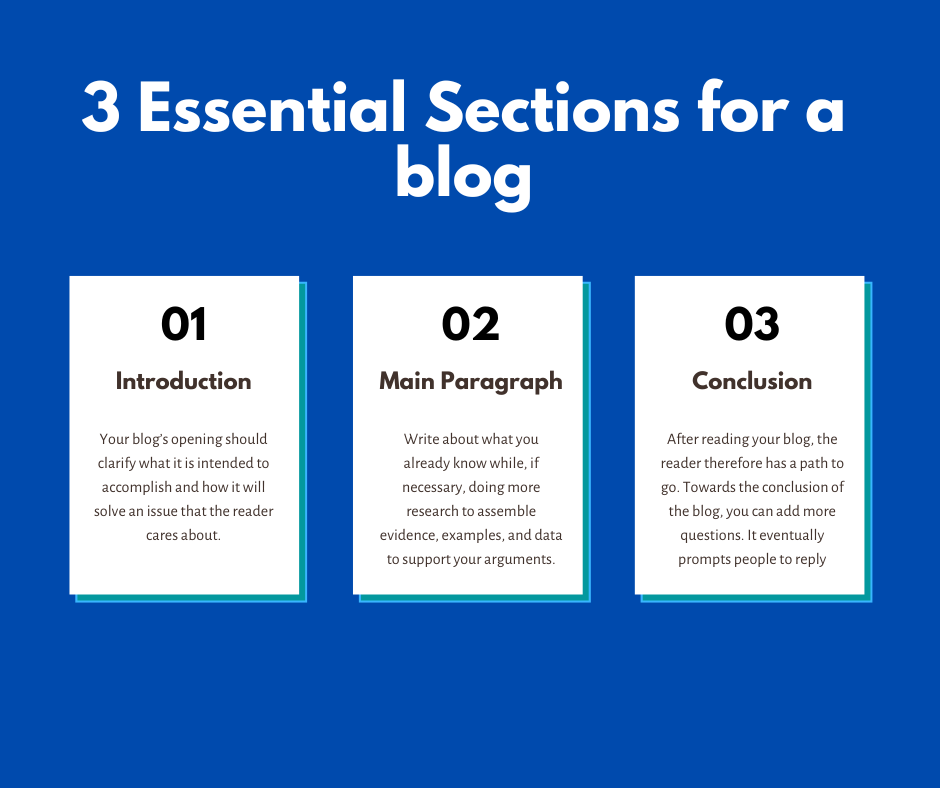
Introduction
Your blog’s opening should clarify what it is intended to accomplish and how it will solve an issue that the reader cares about. This will offer readers a reason to keep reading the blog and read the suggested solution to enhance their personal or professional lives.
Main Content
The next stage is to compose the real text and improve on the stuff that the AI tools have suggested. Explain everything in detail while using the guidelines generated by AI tools as your guide. Write about what you already know while, if necessary, doing more research to find evidence, examples, and data to support your arguments.
Conclusion
The blog’s closing paragraph (conclusion) acts as a summary of the topic as well as a road map for the reader’s next steps. You may offer extra links to other pages or sources to encourage visitors to read more. The reader now has a route to follow after reading your blog. You can add more questions at the end of the blog. Finally, ask people to respond.
Whenever you refer to content from another blog, a website, an article, a case study, a report, or anything else, it must be cited (with a link) inside your post – even if you’re paraphrasing!
Finally, when the content is finished, you should either go back and make any necessary corrections or have it professionally proofread.
Optimize for on-page SEO

The most important aspect of your blog is this section, which will make sure that visitors may find it when they type in the right term in a search engine like Google, Bing, or another one. To improve my SEO rating and give me a chance to show up on the top three search engine results pages, I discovered a few WordPress plugins. If you don’t use WordPress, you may evaluate your page’s searchability using a variety of free online SEO checkers.
WordPress Plugins
Online SEO Checker
Here is a checklist that these tools would run for your content (I am using the AIOSEO tool for this):
Title, Description and Focus Keyphrase
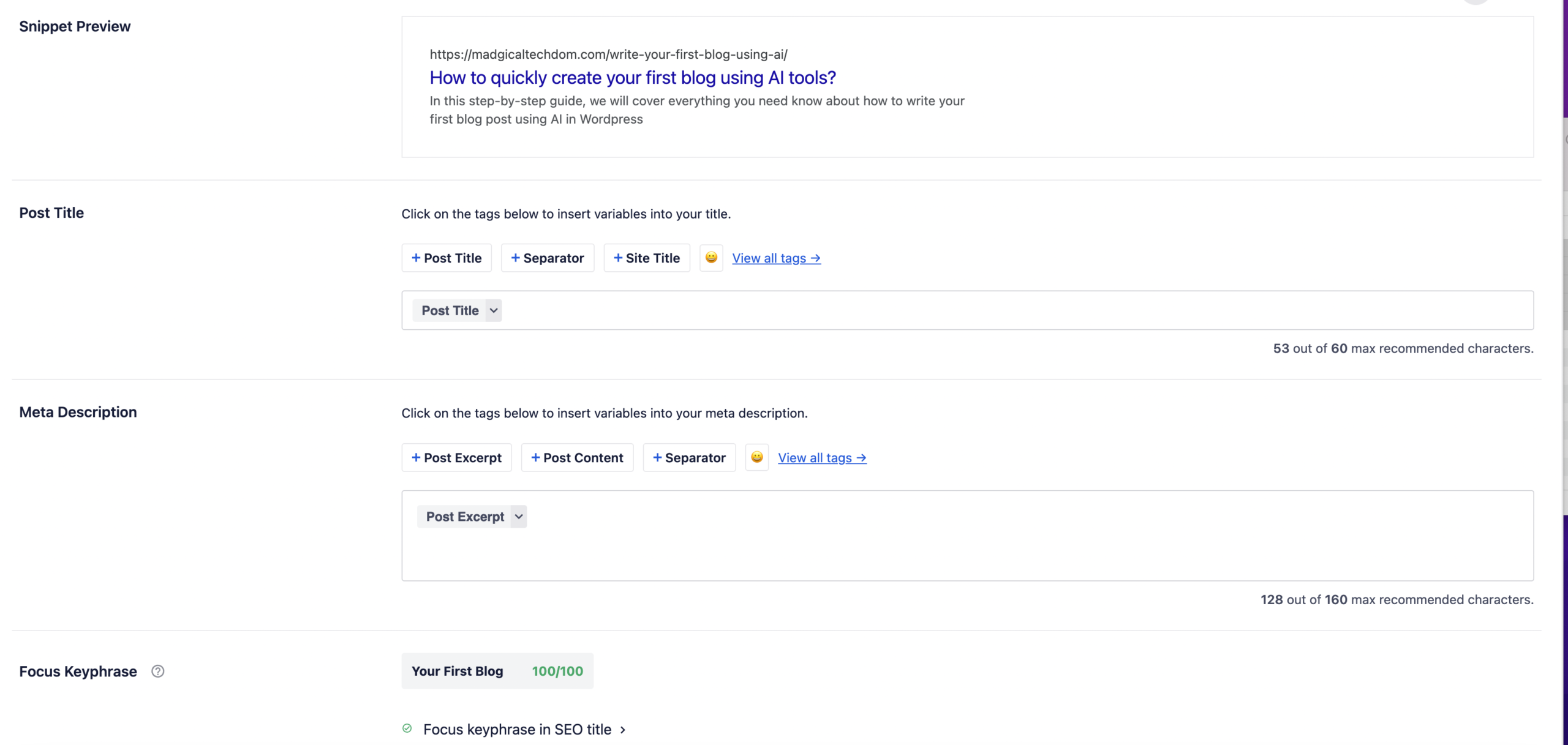
In terms of SEO, these are the blog’s most vital components. You can use semrush tool to generate your Keyphrase.
Here are some considerations that you should make, as shown in the above image:
- Focus Keyphrase – The main keyword of your blog which you want user to type on a seach engine.
- Post Title – Title of the blog should be ~ 60 characters so that it could be displayed correctly on search engine page. It should also contain Focus Keyphrase in it
- Meta Description – This should be ~ 160 characters and should contain the Focus Keyphrase in it.
Basic SEO Page Analysis
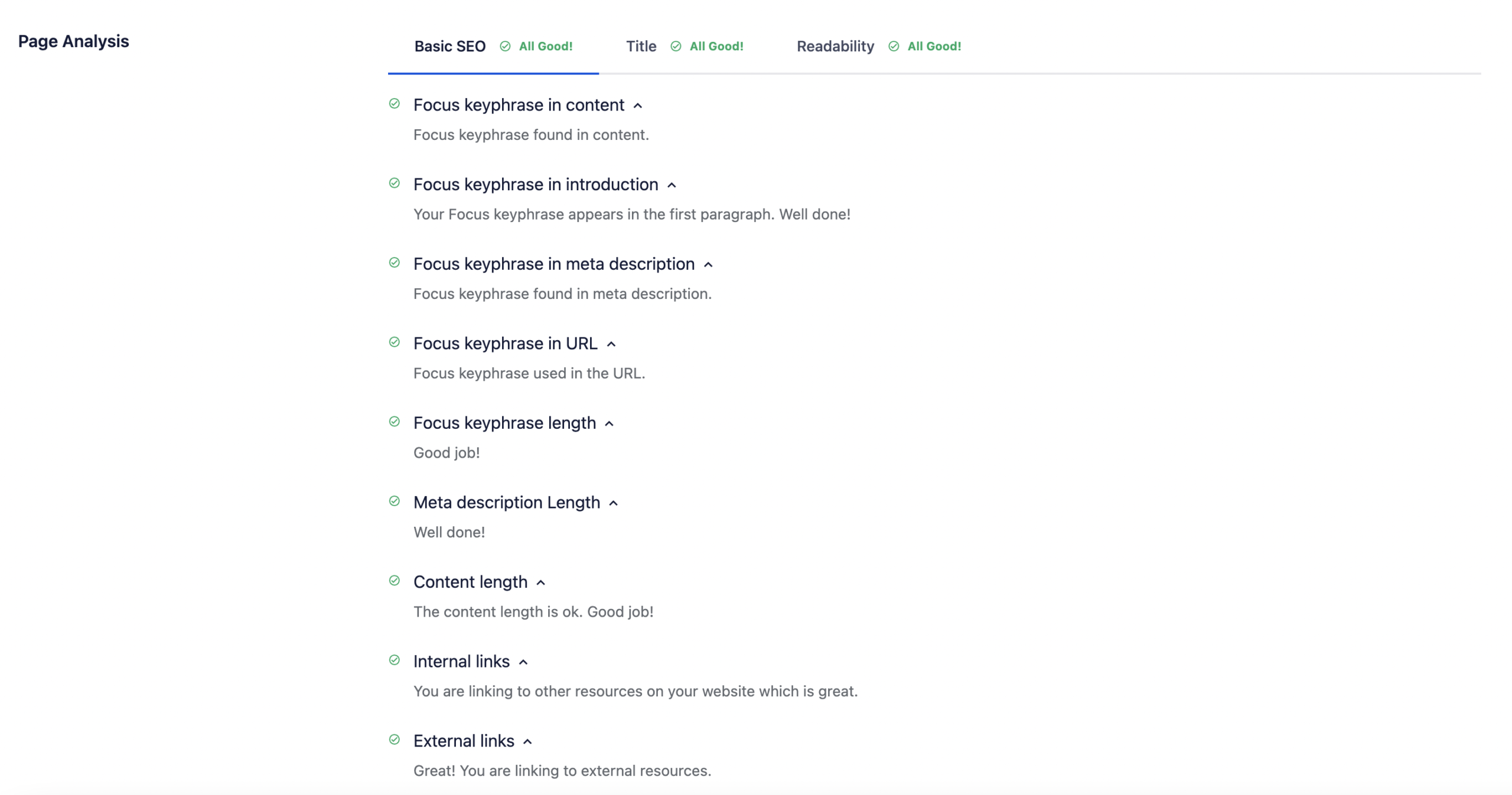
As shown in the picture above, here are some things to consider for Page SEO:
KeyPhrase
- Keyphrase in meta description: This defines whether the keyword you selected appears in your meta description. The keyword must be absolutely the same. Words cannot be divided; they must appear absolutely as written into the Keyphrase fields.
- Keyphrase in URL: This defines whether the keyphrase you have entered appears in the URL. The keyphrase must match exactly.
- Keyphrase in introduction: This defines whether the keyphrase you have entered appears in the first sentence of your content. The keyphrase must match exactly.
- Keyphrase in subheadings: This defines whether the keyphrase you have entered appears in any H2 or H3 headings. The keyphrase must match exactly.
- Keyphrase in image Alt: This defines whether the keyphrase you have entered appears in the Alt text for your images. The keyphrase must match exactly.
- Keyphrase in content: This defines whether the keyphrase you have entered appears in your content. The keyphrase must match exactly.
- Keyphrase length: This checks to see if your keyphrase contains more than four words.
Basic SEO
- Meta description length: In the Meta Description field, we recommend that you include a precise summary of your page or post. This description should be no more than 160 characters long and no less than 120 characters long.
- Content length: For this validation to succeed, we need a minimum of 300 words. This verification can be safely ignored because not all material will be 300 words or more. It is recommended to focused on the quality of your article rather than the numbers of words.
- Internal links: Your article’s content should have internal links to related blogs or pages on your site. We recommend that you add at least one internal link.
- External links: Consider providing connections to related stuff outside your site whenever relevant and accessible.However, external links aren’t as necessary as internal links, and they won’t appear in every piece of content.
Title Page Analysis

As shown in the above figure, here are some things to think about:
- Keyphrase in title: This defines whether the keyword you have entered appears in your SEO title. It must match exactly in the title.
- Keyphrase at the beginning of SEO title: This defines whether the keyphrase you have entered appears in the first few words of your SEO title. The keyphrase must match exactly.
- SEO title length: We recommend that your SEO title should be a minimum of 40 characters and no longer than 60 characters.
Readability Page Analysis
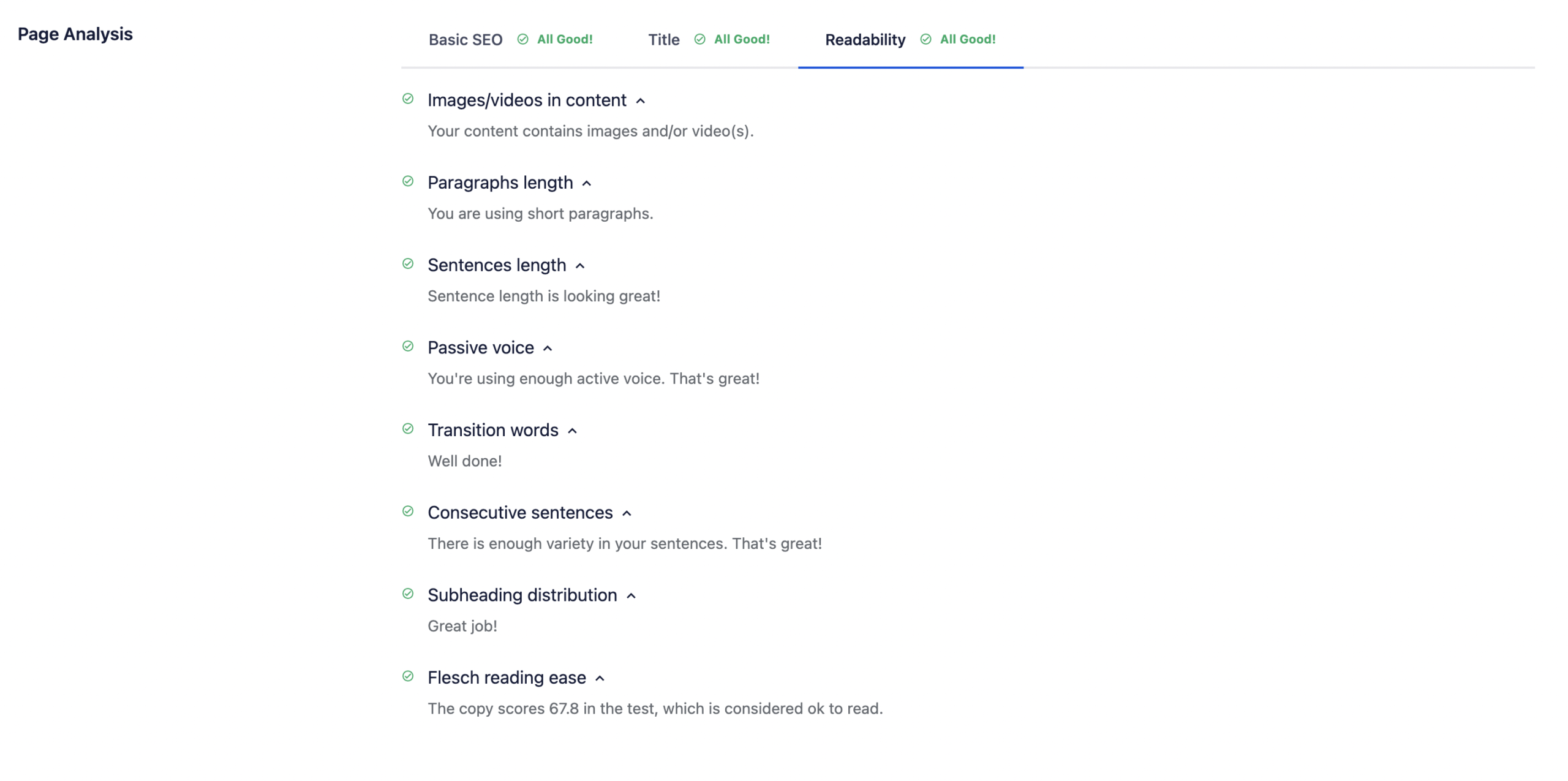
As shown in the above figure, here are some things to think about:
- Images/Videos in content: Google has discovered that material with photos or videos attracts more visitors and increases visitor duration on page. You are advised to include relevant photos and videos in your work whenever possible.
- Paragraph length: We’re looking for paragraphs with more than 120 words since they make it more difficult to engage your visitors, resulting in less time spent on the page.
- Sentence length: This evaluates your text for lengthy or short sentences. The recommended word count is 20. As a result it improves the readability of your information for your readers.
- Passive voice: This checks for active voice versus passive voice. A good article about active vs passive voice can be found on Grammarly here.
- Transition words: This checks to see if your content contains transition. A good article about transition words can be found on Grammarly here.
- Consecutive sentences: This checks to see if you’re using the same word at the start of more than one sentence in a row. As a result it helps you avoid repetition in your content.
- Subheading distribution: This checks to see if you’re using H2 and H3 headers to break up lengthy material. We seek for content that is more than 300 words long and does not have an H2 or H3 header. These headers assist users in reading material by dividing lengthy plain text into logical pieces with section titles (headings).
- Flesch reading ease: This uses the commonly used Flesch-Kincaid readability tests to check how easy it is to read your content.
Promoting your blog on Social Media Websites
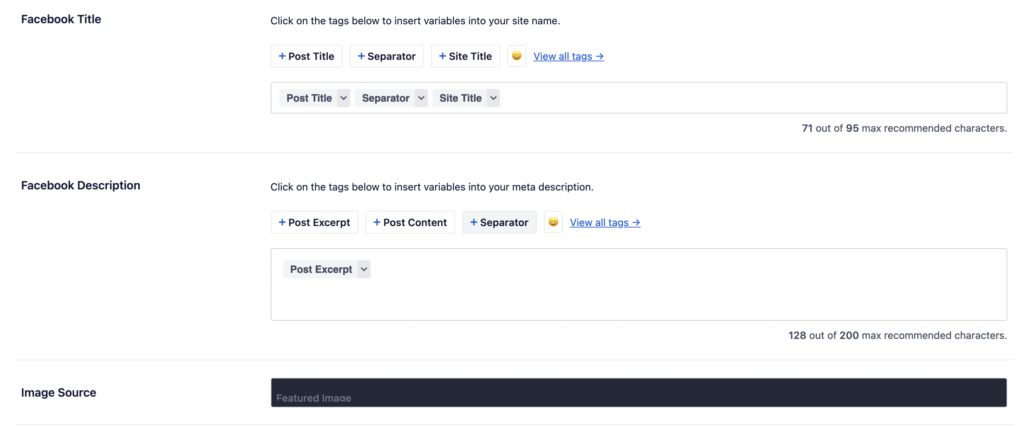
Lastly, You can configure the SEO for social by adding the title, description and image source (featured image) for Facebook. Likewise do the same for Twitter.
When you have completed the SEO validation, the next step is to promote your blog. You can post your blog on social networking sites like Facebook, Twitter, Linkedin, Youtube, or on websites that are specifically for your blog. Of course, you can ask your family or friends to promote your blog
Conclusion
Hopefully, this guide has helped you understand how to write your first blog post. You’ve learned about the importance of having a well-thought-out plan before you sit down to write your blog post.
I have also created a video on our YouTube channel that also explains the content of this blog, which consequently helps you write your almost perfect blog.
You know that it’s important to write for your readers, not just for yourself. When it comes time to publish your blog post, make sure to schedule it for the appropriate time. You don’t want to publish your blog post at 2 A.M. while your readers are sleeping!
Also, make sure to promote your blog post. It’s no good if only you read it! Promote your blog post on social media and email newsletters. You can also try to get other blogs to republish your blog post. You never know what might come of it!
Did you find the tips in this article to be useful? What are some of your favourite ways to conclude a blog post? How have they performed for you?
References
- How to Organise your Life – Building a Second Brain
- 20 Blogging Mistakes to Avoid in 2022, According to HubSpot Bloggers
- How to start writing a blog post?
- Blog Title Generator
- Improve content readability
- Create an Image for the blog
- Understanding the TruSEO Page Analysis Recommendations
- Contact Us